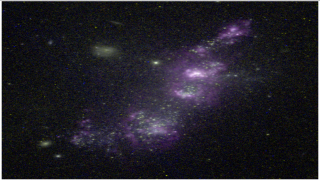Bibcode
Chanchaiworawit, K.; Guzmán, R.; Rodríguez Espinosa, J. M.; Castro-Rodríguez, N.; Salvador-Solé, E.; Calvi, R.; Gallego, J.; Herrero, A.; Manrique, A.; Marín-Franch, A.; Mas-Hesse, J. M.; Aretxaga, I.; Carrasco, E.; Terlevich, E.; Terlevich, R.
Referencia bibliográfica
Monthly Notices of the Royal Astronomical Society, Volume 469, Issue 3, p.2646-2661
Fecha de publicación:
8
2017
Número de citas
13
Número de citas referidas
12
Descripción
We present the results of our search near the end of the Reionization
Epoch for faint galaxies. This has been done using very deep OSIRIS
images obtained at the Gran Telescopio Canarias (GTC). Our observations
focus around two close, massive Lyman α emitters (LAEs) at
redshift 6.5, discovered in the SXDS field within a large-scale
overdense region. The total GTC observing time in three medium band
filters (F883w35, F913w25 and F941w33) is over 34 h covering 7.0 ×
8.5 arcmin2 (or ˜30 000 Mpc3 at z = 6.5). In
addition to the two spectroscopically confirmed LAEs in the field, we
have identified 45 other LAE candidates. The preliminary luminosity
function derived from our observations, assuming a spectroscopic
confirmation success rate of 2/3 as in previous surveys, suggests this
area is about 2 times denser than the general field galaxy population at
z = 6.5. If confirmed spectroscopically, our results will imply the
discovery of one of the earliest protoclusters in the Universe, which
will evolve to resemble the most massive galaxy clusters today.
Proyectos relacionados

Grupo de Estudios de Formación Estelar GEFE
El proyecto interno GEFE está enmarcado en el proyecto coordinado, ESTALLIDOS, financiado por el plan nacional desde el año 2001. El ultimo proyecto aprobado es ESTALLIDOS 6.0 (AYA2016- 79724-C4-2-P). En el proyecto GEFE trabajamos en base al caso científico del proyecto ESTALLIDOS 6.0. Los estallidos de formación estelar (Starbursts o SB) son
Casiana
Muñoz Tuñón

Propiedades Físicas y Evolución de Estrellas Masivas
Las estrellas masivas son objetos claves para la Astrofísica. Estas estrellas nacen con más de 8 masas solares, lo que las condena a morir como Supernovas. Durante su rápida evolución liberan, a través de fuertes vientos estelares, gran cantidad de material procesado en su núcleo y, en determinadas fases evolutivas, emiten gran cantidad de
Sergio
Simón Díaz